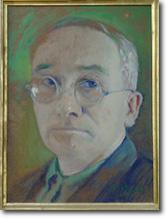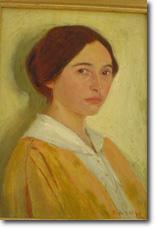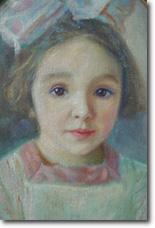|
Theodor Wacyk (1886-1968)
 |
|
Theodor Wacyk was born in 1886 in the
Galician village of Kolodziejówka, now Kolodiivka
in present-day Ukraine. Theodor spent his youth and
attended the Ukrainian Gymnazium in Tarnopol (Ternopil).
Having shown artistic talent at a very early age, in
1904 he was enrolled at the Academy of Fine Arts of
the former Polish capital of Kraków.
He studied there under a number of accomplished artists
and won many prizes and honours. After completing his
studies in 1909, he continued his artistic education
in Vienna, Munich and Venice, before settling in L'viv
between 1910 and 1914.
|
At the outbreak of World War I, Theodor Wacyk volunteered
in the Austro-Hungarian Army and was posted on the Italian
front. While in Italy, he married Maria Battisti (pictured
here) and the couple had a daughter, Theodora, in 1918.
At the end of the War, he joined the Ukrainian struggle
for independence in the Ukrainian Galician Army, and
advanced with his unit nearly as far as Odessa. At the
end of this unsuccessful struggle, he returned to his
family in northern Italy to pursue his artistic work.
The couple separated within a few years, and Wacyk’s
wife and daughter emigrated to the United States. Theodor
left for Czechoslovakia, settling in Transcarpathia
and northern Moravia. There he combined teaching with
his artistic work, painting the frescoes of the Greek
Catholic church of Velyki Kom'iaty in 1931-32.
|
|
 |
Theodor Wacyk remarried in 1933, and he and his new wife
returned to his hometown of Tarnopol in 1935. In the late
1930s or early 1940s, he was commissioned to paint the frescoes
of the recently completed Greek
Catholic church of Tovste. Further research is needed
to determine whether or not any of the original frescoes remain.
The church was repainted in 1968 and the interior was thoroughly
renovated again, around 2005, so it is quite possible that
his work is no longer on display.
Within a few years of painting the frescoes in Tovste, Theodor
Wacyk left Ternopil definitively, eventually settling in Germany,
in the Bavarian town of Plattling, where he continued his
work until his death in 1968.
 |
|
Theodor Wacyk’s artistic path was
interrupted by two world wars. Many of his works were
lost during World War II and were never recovered. His
frescoes in the Greek Catholic church of Velyki Kom'iaty
in Ukraine have survived.
His portraits, landscapes, nudes, still-lifes (usually
floral), figure compositions, genre paintings –
done in oils, pastels, watercolors, ink and pen –
are treated realistically with a tendency to impressionism.
His works of a religious nature – church frescoes,
icons – are done in neo-byzantine style.
|
His paintings are known to be in the National Museum in L'viv
(Ukraine), the Museum of Local Lore in Ternopil (Ukraine),
the Ukrainian Museum in New York (United States) and the KUMF
Gallery in Toronto (Canada), as well as in private collections
in Italy, Belgium, United States, Germany and Brazil.
His works are also known to have been exhibited in Germany,
United States, Ukraine, Poland and Italy. A summary of Theodor
Wacyk’s life can be found on the Ukrainian Research
Institute website of Harvard University: https://www.huri.harvard.edu/lib/archives/wacyk.html
* * * *
Footnote: Apart from this prolific
artist’s connection to Tovste, what makes the story
of Theodor Wacyk so fascinating is how it came to be uncovered
by his granddaughter (from his first marriage), Jaqueline
Bernard, who has provided the contents of the account written
above.
Having been under the impression that her grandfather died
in 1920, she was amazed to discover – over three decades
after his actual death – that Theodor Wacyk had led
such a productive life. Together with her husband Alphonse,
Ms. Bernard is currently writing a personal account of her
voyage of discovery, which has led them to Poland, United
States, Australia and Brazil.
Click here to download
a more comprehensive biography of Theodor Wacyk, including
a description of exhibitions of his work, critical reviews
and references.

|

